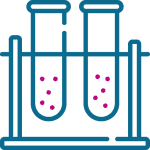Cancer marker CA 72-4 (stomach)
The best laboratory indicator for gastric cancer. Blood levels of the indicator are monitored to track the progress of gastric cancer
22,00 €

The gastric cancer marker (Ca 72-4) is the best laboratory indicator of gastric cancer. Blood levels are used to monitor the progress of gastric cancer, assess response to treatment and the radicality of surgery. Doctors recommend testing for three cancer markers at the same time – gastric cancer marker (Ca 72-4), pancreatic cancer marker (Ca 19-9) and carcinoembryonic antigen (CEA) – in order to get the most accurate and sensitive test results.
A marker for gastric cancer (Ca 72-4) is often combined with a marker for ovarian cancer (Ca 125) to confirm the diagnosis and to assess the course of ovarian cancer. Measured when other tests have already diagnosed cancer.
A laboratory indicator for gastric cancer.
Like other cancer laboratory indicators, this marker has limitations. It is now clearly the best laboratory indicator for gastric cancer and non-mucinous ovarian cancers. This test has a specificity of 100% and a sensitivity of 48% with a cut-off (norm) of 6.7 U/ml. The serum concentration is proportional to the size and spread of the tumour. This indicator should be combined with CA 125 to diagnose and assess the course of ovarian cancer. Some ovarian cancers do not respond to CA 125, so it is convenient to use both markers when suspicious. The same principles of identifying and interpreting cancer markers are important in the pre- and post-operative follow-up of gastric cancer (see “Cancer markers”). For gastric cancer, it is commonly suggested to use three parameters simultaneously – CA 72-4, CA 19-9 and CEA. If tumour diagnosis, progression or post-operative weight loss is best matched by changes in one of these indicators, then follow-up of gastric cancer should be based on that particular indicator.
You can consult our family doctors.
